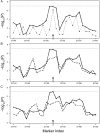Haplotype-based association analysis via variance-components score test
- PMID: 17924336
- PMCID: PMC2265651
- DOI: 10.1086/521558
Haplotype-based association analysis via variance-components score test
Abstract
Haplotypes provide a more informative format of polymorphisms for genetic association analysis than do individual single-nucleotide polymorphisms. However, the practical efficacy of haplotype-based association analysis is challenged by a trade-off between the benefits of modeling abundant variation and the cost of the extra degrees of freedom. To reduce the degrees of freedom, several strategies have been considered in the literature. They include (1) clustering evolutionarily close haplotypes, (2) modeling the level of haplotype sharing, and (3) smoothing haplotype effects by introducing a correlation structure for haplotype effects and studying the variance components (VC) for association. Although the first two strategies enjoy a fair extent of power gain, empirical evidence showed that VC methods may exhibit only similar or less power than the standard haplotype regression method, even in cases of many haplotypes. In this study, we report possible reasons that cause the underpowered phenomenon and show how the power of the VC strategy can be improved. We construct a score test based on the restricted maximum likelihood or the marginal likelihood function of the VC and identify its nontypical limiting distribution. Through simulation, we demonstrate the validity of the test and investigate the power performance of the VC approach and that of the standard haplotype regression approach. With suitable choices for the correlation structure, the proposed method can be directly applied to unphased genotypic data. Our method is applicable to a wide-ranging class of models and is computationally efficient and easy to implement. The broad coverage and the fast and easy implementation of this method make the VC strategy an effective tool for haplotype analysis, even in modern genomewide association studies.
Figures



Similar articles
-
Incorporating single-locus tests into haplotype cladistic analysis in case-control studies.PLoS Genet. 2007 Mar 23;3(3):e46. doi: 10.1371/journal.pgen.0030046. PLoS Genet. 2007. PMID: 17381242 Free PMC article.
-
Tests of association between quantitative traits and haplotypes in a reduced-dimensional space.Ann Hum Genet. 2005 Nov;69(Pt 6):715-32. doi: 10.1111/j.1529-8817.2005.00216.x. Ann Hum Genet. 2005. PMID: 16266410
-
Statistically efficient association analysis of quantitative traits with haplotypes and untyped SNPs in family studies.BMC Genet. 2020 Sep 7;21(1):99. doi: 10.1186/s12863-020-00902-x. BMC Genet. 2020. PMID: 32894040 Free PMC article.
-
The role of haplotypes in candidate gene studies.Genet Epidemiol. 2004 Dec;27(4):321-33. doi: 10.1002/gepi.20025. Genet Epidemiol. 2004. PMID: 15368617 Review.
-
[Construction of haplotype and haplotype block based on tag single nucleotide polymorphisms and their applications in association studies].Zhonghua Yi Xue Yi Chuan Xue Za Zhi. 2007 Dec;24(6):660-5. Zhonghua Yi Xue Yi Chuan Xue Za Zhi. 2007. PMID: 18067078 Review. Chinese.
Cited by
-
Optimal unified approach for rare-variant association testing with application to small-sample case-control whole-exome sequencing studies.Am J Hum Genet. 2012 Aug 10;91(2):224-37. doi: 10.1016/j.ajhg.2012.06.007. Epub 2012 Aug 2. Am J Hum Genet. 2012. PMID: 22863193 Free PMC article.
-
Gene and Network Analysis of Common Variants Reveals Novel Associations in Multiple Complex Diseases.Genetics. 2016 Oct;204(2):783-798. doi: 10.1534/genetics.116.188391. Epub 2016 Aug 3. Genetics. 2016. PMID: 27489002 Free PMC article.
-
Meta-analysis of sequencing studies with heterogeneous genetic associations.Genet Epidemiol. 2014 Jul;38(5):389-401. doi: 10.1002/gepi.21798. Epub 2014 May 5. Genet Epidemiol. 2014. PMID: 24799183 Free PMC article.
-
PSCAN: Spatial scan tests guided by protein structures improve complex disease gene discovery and signal variant detection.Genome Biol. 2020 Aug 26;21(1):217. doi: 10.1186/s13059-020-02121-0. Genome Biol. 2020. PMID: 32847609 Free PMC article.
-
Analytic P-value calculation for the higher criticism test in finite d problems.Biometrika. 2014;101(4):964-970. doi: 10.1093/biomet/asu033. Biometrika. 2014. PMID: 25750439 Free PMC article.
References
Web Resources
-
- Authors’ Web site, http://www4.stat.ncsu.edu/∼tzeng/Softwares/Hap-VC/R/ (for R code for implementing the VC-score test)
-
- NINDS Human Genetics DNA and Cell Line Repository, http://ccr.coriell.org/ninds/ (for the ALS study by Schymick et al.)
-
- Online Mendelian Inheritance in Man (OMIM), http://www.ncbi.nlm.nih.gov/Omim/ (for DOCK1) - PubMed
References
Publication types
MeSH terms
Grants and funding
LinkOut - more resources
Full Text Sources
Research Materials

